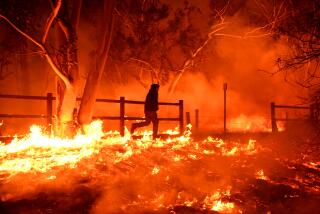How local farmers are coping with the devastating Thomas fire
There are no more limequats left on Mud Creek Ranch. The Kishu mandarins are crumpled and Pixie tangerines hang like lumps of black coal, but it was the avocados that suffered the most. From a distance, the fruit on a 50-year-old Fuerte tree could pass for Bosc pears, their tear-shaped avocados cooked to a caramel color. Nearby red sap oozes from the trunks of Hass and Pinkertons, as though they were bleeding.
The Thomas Fire, which as of Monday had ravaged over 270,000 acres in Ventura and Santa Barbara counties, started a quarter of a mile from Mud Creek Ranch, a 65-acre swath of land in Santa Paula Canyon where Steven and Robin Smith grow organic avocados and more than 200 varieties of citrus.
It was Dec. 4 when Smith heard the dogs barking and walked out his kitchen door to find flames crawling toward his property.
“The fire was coming over that ridge right there,” he says, pointing to a charred hillside. “And the wind was really howling, maybe 40 knots.”
When a second firestorm barreled down Mud Creek and ignited a neighbor’s woodpile, Smith knew it was time to go. “There were embers flying at 40 miles per hour,” he recalls. “The fire department was here but they had to bail; it was too overwhelming.”
On the morning of Dec. 5, when the Smiths returned home, their barn, workshop, garage — and a historic house built in the 1880s where the Smiths stored their family heirlooms — were reduced to piles of ash. An estimated 5,000 of 20,000 trees were damaged, and their house was moments away from igniting after a 40-foot tall cluster of burning bamboo had fallen onto the roof. The city’s water line was down, so Steven and his son Matthew put the bamboo fire out with their dogs’ 15-gallon drinking water buckets.
The Smiths’ harrowing story is one of many circulating among neighbors in this farming community where residents have lost houses, vehicles, barns and entire hillside plantings as the fire cut through the steep canyons.
Fourth-generation farmer Jamie Johnson, whose properties in Ojai, Carpinteria and Fillmore all suffered fire damage, described the destruction in the area as “biblical.”
Despite his efforts irrigating, clearing the ground of dry leaf litter and bulldozing fire lines, the fire plowed into his Fillmore avocado groves on Day 12 of the blaze. “It was like a freight train,” he recalls. “It was just unstoppable. You have no control and once it goes, it goes.”
This region is no stranger to fire or drought or freeze.
Ventura County holds nearly 16,000 of the state’s 54,000 acres of avocado production, more than any other region in California. About 4,500 acres are inside the burn zone, according to Farm Bureau of Ventura County Chief Executive John Krist, but the damage varies greatly from grower to grower.
“One grower I know is estimating as much as 80% of avocados are gone,” Krist says. “For others it just nibbled around the edges, but it will be a few weeks before we can really get a good handle on dollar value.”
Last year, Ventura County produced 90 million pounds of avocados, and this year “we were on track to double that,” says California Avocado Commission President Tom Bellamore. Avocados are an alternate bearing crop, meaning they produce a heavy yield one year and a light yield the next. Bellamore estimates that this year’s bumper crop means that, despite the losses, it’s unlikely that customers will notice a shortage in the marketplace.
Avocados were especially hard-hit because, unlike citrus which are planted on flat ground, they are often planted on hillsides, where it’s harder for firefighters to battle the flames, and it’s common practice to let dead leaves fall to the ground, where they become ready tinder in a wildfire.
While terrifying images of hillsides and palm trees ablaze have mesmerized the public, the strong Santa Ana winds fueling the fire may prove to be more damaging for farmers who are dealing with avocados blowing off the trees, rendering them unsellable, and citrus banging against the trunks and branches, which bruises the fruit and reduces its value.
“Usually a Santa Ana lasts a couple of days and you get a break,” Krist says. “For the wind to blow two weeks is just unheard of.”
The wind also spreads smoke damage, according to Ben Faber, a farm advisor with UC Cooperative Extension. “There are a lot of gases in the smoke like ethylene that is a ripening agent,” he explains. “I was out looking at a cherimoya orchard in Carpinteria on Friday, and it didn’t get hit by fire or heat, but there were a lot of cherimoyas on the ground.”
In addition to wind, smoke and fire, rows of lettuces and strawberries in the flatlands are covered in ash and the air quality in the county ranges from “unhealthy for certain groups” to “hazardous.”
Kenter Canyon Farms’ Andrea Crawford, who grows lettuces and other greens on the edge of the fire in Fillmore, questioned what would happen to her crop. “There’s a lot less sunlight,” she said by phone, and indeed, driving down Highway 150, the California sunshine appears to have been smudged out by a dirty eraser, replaced by hazy vistas and an ominous orange glow.
Tens of thousands of acres of grazing land have been charred, leaving behind a moonscape of black hillsides pockmarked with ash and brittle stumps, which worries Krist.
“Those hillsides will regenerate over time,” he says, “but if we get considerable rains this winter they are susceptible to debris flow and erosion which in the near future is a big concern.”
Back at Mud Creek Ranch, Steven Smith’s immediate concerns are tightening up irrigation systems so they can stay on track with the crops that aren’t damaged, and talking with farm agencies about recovery.
“Everything is insured, but it’s beside the point,” Smith says. “A lot of those heirlooms, I don’t know how you put a price on that.”
Until the various agencies have assessed the farm, the Smiths have been advised not to touch anything, which means they confront a pit of ashes every time they leave the front door. And they’re left running a business without any infrastructure to pack or store fruit for their weekly farmers market hauls.
While the customers at farmers markets won’t see any drastic changes to Mud Creek’s offerings, 80% of Smith’s avocados are sold to packing houses, and after the fire, he is considering replacing many of his damaged trees with lemons, which proved less susceptible to the wildfire.
Smith’s daughter Marguerita, 27, who was born and raised on the farm and continues to work in the family business, sees the loss more personally. “For us this is our life and our story. That avocado tree used to be my fort,” she says, pointing to a cluster of singed foliage. “And the bamboo forest was my hide-out.”
Ultimately, Marguerita says her family is grateful to have one another. “Sure, we’re bummed about it, and the family photos are gone,” she says. “But we’ll just make new ones.”
ALSO:
Jonathan Gold’s 10 best dishes of 2017
For Hanukkah, a celebration of olio nuovo, or new olive oil
More to Read
Eat your way across L.A.
Get our weekly Tasting Notes newsletter for reviews, news and more.
You may occasionally receive promotional content from the Los Angeles Times.






